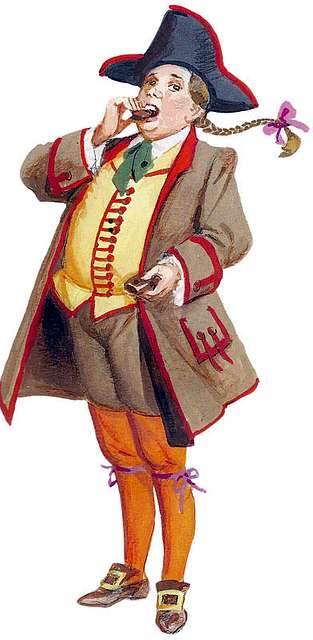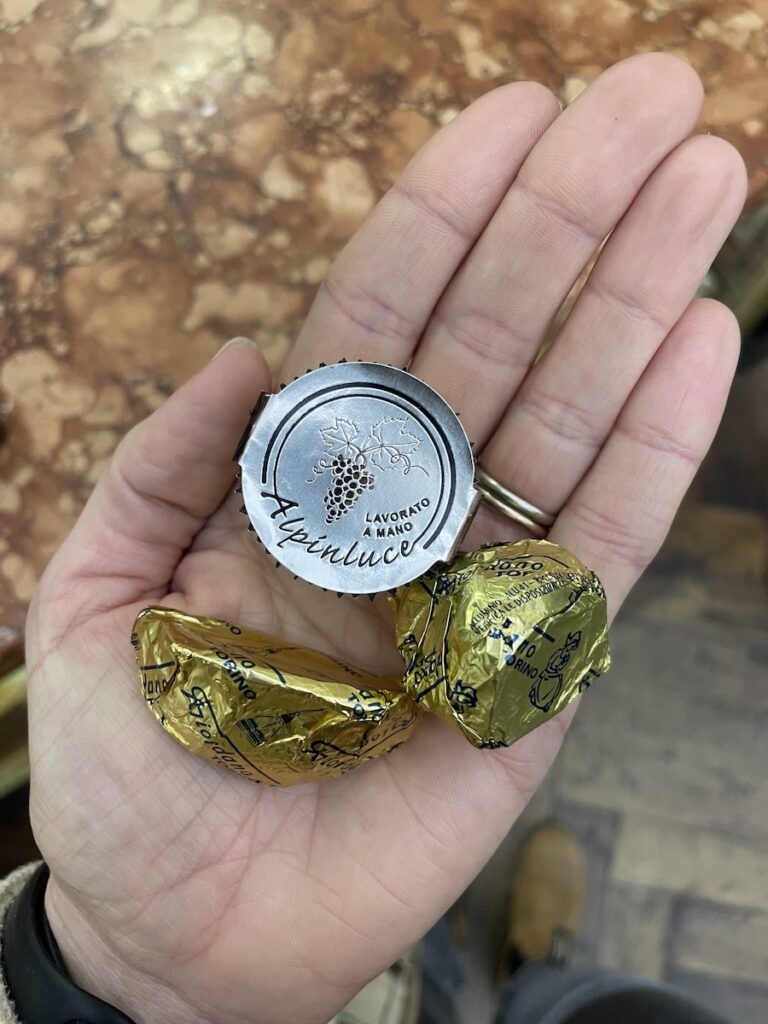Though you might not expect it, Torino has a lot going on. It’s the original capital of Italy, the city of FIAT, the “Paris of Italy”, where Vermouth Hour became Aperitivo, where espresso was invented. And as you might already know, Torino is also the city of chocolate.
For those of you who didn’t know, let me catch you up to speed. Torino chocolate is mainly known for gianduiotti and gianduja, which essentially would be what most of you call “Nutella”. Yet locals will shake their heads at the reference. Nutella, in fact, was invented by Ferrero in nearby Alba. It is based on hazelnut chocolate, but it includes far more additives than the classic Gianduja, which is a base of only hazelnuts, chocolate, and sugar.
Take a walk through the city and you’ll see many vetrine filled with delicious chocolate assortments. Most cafes also serve either a Bicerin or a Marocchino, both specialties with a little added chocolate. Oh, and now we also have a Museum of Chocolate. It’s definitely the place to be if chocolate is your thing. But how did Torino become this chocolate city?
Torino Chocolate: A Little History
Where there was royalty in Europe, you can bet there was chocolate. It was a commodity that showed off wealth and worldliness.
Cocoa beans were brought to Europe by way of Southern and Central America in the 16th century. In fact, already by 1568, Emanuele Filiberto of Savoy brought hot chocolate to Turin, introducing the first chocolate to Italy. He poured a steaming cup of hot chocolate to mark the movement of the Savoy Duchy to Turin. So really, the entire history of Turin as a capital has been entwined with chocolate.
Already in the 1700s, Torinesi were drinking a blend of chocolate, coffee, and milk that would eventually transform into the notable Bicerin drink.
Torino was a city filled with Nobles looking to stay close to the Savoy family. Then as the city built up it became a center for academia, artists, and politicians, founding what would become Italy as we know it today.
And where these well-to-do circles thrive, so do coffee houses, and salons serving the rich “drug” of the time. Thus, Torino chocolate and coffee become famous.
The Secret Ingredient
But what makes Torino chocolate, or really any chocolate from Piedmont, so particular is the ingredient of hazelnuts. This addition didn’t exactly come about by choice, though it has become such an identifying flavor of the region. In 1806, Napoleon put out an embargo against the English, and this made getting ingredients from across the ocean a little difficult.
Yet no one was going to cut the Torinesi off from their chocolate. They just had to learn to get creative. So, Piedmontese producers started to take the local Tonda Gentile hazelnuts (a local prized species) and crush them down into a fine powder to strengthen the little cacao supply they had. The result was the absolute delicious gianduja spread.
There was no going back after that. And now today you can enjoy many variations of this famous hazelnut chocolate.
But what about Nutella?
Nutella was invented as a poor man’s chocolate. Ferrero found himself struggling to sell the famous high-end chocolates to a public who had just been devastated by WWII. He instead tried to cheapen the product by adding vegetable oil (and some say cocoa butter, I have read mixed histories). The price point and sweet treat was a hit. And eventually the product became re-packaged as Nutella and sold across stores worldwide. But… once you have tasted the real gianduja, I’m not sure you’ll have the same Nutella obsession as before.
The Signature Torino Chocolates
Well, I say Torino, but that doesn’t give enough credit to the whole region. Actually, these chocolates are well known throughout Piedmont. And in fact, it is the special Tonda Gentile breed of hazelnut grown in the Langhe that gives them their wonderful flavor. Anyway, here’s a few chocolates you should pick up on your next trip:

Giandiuotti and Gianduja:
Both of these products are made with three simple ingredients: hazelnuts, cocoa, and sugar. Usually, craft chocolate makers will tell you there must be over 30% of hazelnuts, and some of the best are between 50-70%. Gianduiotti are the solid version of Gianduja, always found in a little mountain shape. These were created originally by Caffarel in the mid-1800s and happened to be the first individually wrapped chocolates in the world. Today Caffarel has been purchased by Lindt and the recipe has gone commercial so I don’t recommend them (I will put the ones I do love down below).
The name of Gianduja comes from the Piedmontese version of Punch or Pulcinella. He was original known as “Gioan d’la douja’” meaning essentially John of the mug, as he was always with a drink. It was a carnival mask and puppet representing Torino and Piedmont, and well the name stuck.
Cri-Cri
Cri-Cri is one of my favorite little snacks. It is a whole hazelnut, covered in chocolate and the little white sprinkles, wrapped in a colorful foil. There chocolates were already produced and well loved in Turin in the early 1900s. In fact they were created by a pastry maker in Torre Pellice in 1886. But more anecdotal story of the Cri-Cri is not their creation, but how they got their name.
The story goes that a love-struck university student would always bring these candies to his girlfriend, Cristina. He frequented the same pasticceria so often that the sales-person when he walked in would simply ask “Cri?” and he would respond “Cri.” And from then on, that was their name.
Cremino
Cremini are another melt in your mouth chocolate that originated in Turin. These are little squares with two layers of gianduja and a middle layer containing more hazelnut, pistacchio, lemon or whatever the chocolate-maker proposes. These were invented in 1858, by Ferdinando Baratti of Baratti e Milano.
The Best Chocolate in Turin

Baratti e Milano
Founded in 1858 by Ferdinando Baratti and Edoardo Milano, this elegant chocolatier began as a small candy shop near Piazza Castello and quickly became the official supplier to the Savoy royal family. This is still a great cafe to visit for breakfast, a hot chocolate, or just to sneak a quick peek in.
Guido Gubino
Guido Gobino is the modern face of Turin’s chocolate scene. He’s famous for reimagining traditional recipes (his salt gianduiotto is legendary) while keeping the it also purely local. If you stop into his boutique, get yourself an assortment of gianduiotti, you can try ones with differing amounts of hazelnut to taste the difference.
Guido Castagna
Castagna is all about slow chocolate. He follows a “from bean to bar” process that takes six months, giving every bite that perfect silky melt. His shop is smaller and more artisanal than Gobino’s, but his gianduiotti have won many awards, and his bar chocolate is also incredible!
Peyrano:Founded in 1915, Peyrano is one of Turin’s older and most respected chocolatiers. For decades, they supplied the Italian royal family, and other big names in Turin society, and became known for their elegant packaging and impeccable technique. Their shop is just across the river by Gran Madre.
Giordano: Giordano is a Turin institution, it also happens to have a factory in Leini, where my husband is from.. The shop has been open since 1897, right near Porta Nuova, and it still feels like a family-run pasticceria. They’re known for their hand-made and hand-wrapped gianduiotti and for always sneaking an extra chocolate or two into your bag. But to be honest… they better because they are also one of the most expensive chocolates! Apart from their gianduiotti I highly recommend the giacometti which have chunks of hazelnut in them!
Stratta
Since 1836, they’ve been making chocolates and candies for Turin’s elite, and they were even the official confectioners of the Savoy court. I love them for their coffee, in fact, it’s my first recommendation when coming to Turin. But they also have these delicious Gioie di Cavour – think of them as the original ferrero rocher. It’s a creamy gianduja or pistachio cream center, held in with a chocolate cover with hazelnut chunks. The story goes the Primo Benso, the Count of Cavour (Italy’s first Prime Minister) would stop by here for his hot chocolate. When he did he would roll his spoon in a bowl of hazelnuts and stir them into the drink. Thus, Strata created this chocolate as an homage to him
Pfatisch
Founded in 1915, the shop is a little further from the center, but still right by Porta Nuova Station, and worth the detour for its vintage charm and incredible truffles. Even the pastry counter is original from the 1920s, and you can still peek into their old underground chocolate lab which now holds the Museum of Chocolate!
If you found this information helpful you can show your support by buying me a glass of wine 🥂. I really appreciate it and each glass inspires me to research more into life in Italy!
And if you are looking for more help on your journey of making Italy home or looking for local insight to plan the best trip, get in touch, let me help you experience authentic Italy.
